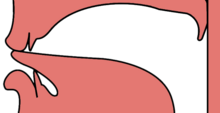Consonant produced with tongue against the upper lip
| Linguolabial | |
|---|---|
| ◌̼ |
Linguolabials or apicolabials are consonants articulated by placing the tongue tip or blade against the upper lip, which is drawn downward to meet the tongue. They represent one extreme of a coronal articulatory continuum which extends from linguolabial to subapical palatal places of articulation. Cross-linguistically, linguolabial consonants are very rare. They are found in a cluster of languages in Vanuatu, in the Kajoko dialect of Bijago in Guinea-Bissau, in Umotína (a recently extinct Bororoan language of Brazil), and as paralinguistic sounds elsewhere. They are also relatively common in disordered speech, and the diacritic is specifically provided for in the extensions to the IPA.
Linguolabial consonants are transcribed in the International Phonetic Alphabet by adding the "seagull" diacritic, U+033C ◌̼ COMBINING SEAGULL BELOW, to the corresponding alveolar consonant, or with the apical diacritic, U+033A ◌̺ COMBINING INVERTED BRIDGE BELOW, on the corresponding bilabial consonant.
Description

Linguolabials are produced by constricting the airflow between the tongue and the upper lip. They are attested in a number of manners of articulation including stops, nasals, and fricatives, and can be produced with the tip of the tongue (apical), blade of the tongue (laminal), or the bottom of the tongue (sublaminal). Acoustically they are more similar to alveolars than bilabials. Linguolabials can be distinguished from bilabials and alveolars acoustically by formant transitions and nasal resonances.
List of consonants
| IPA (two transcriptions) |
Description | Example | ||||
|---|---|---|---|---|---|---|
| Language | Orthography | IPA | Meaning | |||
| n̼ | m̺ | linguolabial nasal | Araki | m̈ana | "laugh" | |
| t̼ | p̺ | voiceless linguolabial plosive | Tangoa | p̈ep̈e | "butterfly" | |
| d̼ | b̺ | voiced linguolabial plosive | Kajoko dialect of Bijago | "stone" | ||
| d̼ | b̺ | prenasalized voiced linguolabial plosive | Vao | "bow" | ||
| θ̼ | ɸ̺ | voiceless linguolabial fricative | Big Nambas | "he is asthmatic" | ||
| ð̼ | β̺ | voiced linguolabial fricative | Tangoa | v̈atu | "stone" | |
| ɾ̼ | ⱱ̺ | voiced linguolabial flap | Kajoko dialect of Bijago | "stone" | ||
| l̼ | — | linguolabial lateral approximant | (common in disordered speech) | |||
| ɬ̼ | — | voiceless linguolabial lateral fricative | (in disordered speech) | |||
| ɮ̼ | — | voiced linguolabial lateral fricative | (in disordered speech) | |||
| ɺ̼ | — | linguolabial lateral flap (uses lower lip) | Piraha (part of allophone for /ɡ/, ) | toogixi | "hoe" | |
| r̼ | ʙ̺ | linguolabial trill (uses lower lip) |
Coatlán Zapotec | (paralinguistic) | r̼ʔ | used as mimesis for a child's flatulence. (similar to blowing a raspberry, but involving only upper lip) |
| ǀ̼ or ʇ̼ | ʘ̺ | linguolabial click release (multiple consonants) | Coatlán Zapotec | (paralinguistic) | kǀ̼ | used as mimesis for eating soup or a pig drinking water |
Linguolabials as a diachronic stage in sound shifts
In Vanuatu, some of the Santo–Malekula languages have shifted historically from bilabial to alveolar consonants via an intermediate linguolabial stage, which remains in other Santo and Malekula languages.
While labials have become linguolabial before nonrounded vowels in various languages (e.g. Tangoa, Araki, Nese), the sound shift went further in languages such as Tolomako, which shifted the linguolabials to full alveolar consonants: *b > * > p̈ > t ; *m > m̈ > n . Thus, POc *bebe 'butterfly' > (spelled p̈ep̈e in Tangoa or in Araki) later became in Tolomako. Likewise, POc *tama 'father' > (cf. Tangoa tam̈a, Araki ram̈a) > Tolomako .
See also
Notes
- The term apicolabial is older, but Ladefoged and Maddieson point out that often these sounds are not apical.
- Olson et al. (2009), p. 521.
- Pullum, Geoffrey K.; Ladusaw, William A. (1996). Phonetic Symbol Guide (2nd ed.). p. 256. ISBN 9780226685366. They note that the apical diacritic was added to the IPA after the linguolabial diacritic, and would have made the latter unnecessary.
- Everett (1982).
- Maddieson (1988), p. 350.
- Maddieson (1988), pp. 364–367.
- François, Alexandre (2002). Araki: A disappearing language of Vanuatu. Pacific Linguistics. Vol. 522. Canberra: Australian National University. pp. 15, 270. ISBN 0-85883-493-6.
- A. François, An online Araki-English-French dictionary. Electronic publication: entry m̈ana
- Audio link: excerpt from a text in Araki language (sentence s75), showcasing the form m̈ana (source: Pangloss archive).
- ^ Ladefoged & Maddieson (1996:19)
- ^ Olson et al. (2009), p. 523.
- Everett, Daniel Leonard (December 1982). "Phonetic rarities in Pirahã". Journal of the International Phonetic Association. 12 (2): 94–96. doi:10.1017/S0025100300002498. JSTOR 44526660. S2CID 143928460. Retrieved 27 September 2023.
- ^ Beam de Azcona, Rosemary. "Sound Symbolism" (PDF). Archived from the original (PDF) on 2007-06-23. Retrieved 2008-11-24.
- A. François, An online Araki-English-French dictionary. Electronic publication: entry p̈ep̈e
- A. François, An online Araki-English-French dictionary. Electronic publication: entry r̄am̈a
References
- Ladefoged, Peter; Maddieson, Ian (1996). The Sounds of the World's Languages. Oxford: Blackwell. ISBN 0-631-19815-6.
- Maddieson, Ian (1988). "Linguo-labials". In Harlow, Ray; Hooper, Robin (eds.). VICAL 1: Oceanic Languages: Papers from the Fifth International Conference on Austronesian Linguistics: Part Two. Auckland: Linguistic Society of New Zealand. pp. 349–375.
- Olson, Kenneth; Reiman, D. William; Sabio, Fernando; da Silva, Filipe Alberto (2009). "The voiced linguolabial plosive in Kajoko". Proceedings of the Chicago Linguistic Society. 45 (1): 519–530.
| International Phonetic Alphabet (chart) | ||||||||||||||||||||||||||||||||||||||||||||||||||||||||||||||||||||||||||||||||||||||||||||||||||||||||||||||||||||||||||||||||||||||||||||||||||||||||||||||||||||||||||||||||||||||||||||||||||||||||||||||||||||||||||||||||||||||||||||||||||||||||||||||||||||||||||||||||||||||||||||||||||||||||||||||||||||||||||||||||||||||||||||||||||||||||||||||||||||||||||||||||||||||||||||||||||||||||||||||||||||||||||||||||||||||||||||||||||||||||||||||||||||||||||||||||||||||||||||||||||||||||||||||||||||||||||||||||||||||||||||||||||||||||||||||||||||||
|---|---|---|---|---|---|---|---|---|---|---|---|---|---|---|---|---|---|---|---|---|---|---|---|---|---|---|---|---|---|---|---|---|---|---|---|---|---|---|---|---|---|---|---|---|---|---|---|---|---|---|---|---|---|---|---|---|---|---|---|---|---|---|---|---|---|---|---|---|---|---|---|---|---|---|---|---|---|---|---|---|---|---|---|---|---|---|---|---|---|---|---|---|---|---|---|---|---|---|---|---|---|---|---|---|---|---|---|---|---|---|---|---|---|---|---|---|---|---|---|---|---|---|---|---|---|---|---|---|---|---|---|---|---|---|---|---|---|---|---|---|---|---|---|---|---|---|---|---|---|---|---|---|---|---|---|---|---|---|---|---|---|---|---|---|---|---|---|---|---|---|---|---|---|---|---|---|---|---|---|---|---|---|---|---|---|---|---|---|---|---|---|---|---|---|---|---|---|---|---|---|---|---|---|---|---|---|---|---|---|---|---|---|---|---|---|---|---|---|---|---|---|---|---|---|---|---|---|---|---|---|---|---|---|---|---|---|---|---|---|---|---|---|---|---|---|---|---|---|---|---|---|---|---|---|---|---|---|---|---|---|---|---|---|---|---|---|---|---|---|---|---|---|---|---|---|---|---|---|---|---|---|---|---|---|---|---|---|---|---|---|---|---|---|---|---|---|---|---|---|---|---|---|---|---|---|---|---|---|---|---|---|---|---|---|---|---|---|---|---|---|---|---|---|---|---|---|---|---|---|---|---|---|---|---|---|---|---|---|---|---|---|---|---|---|---|---|---|---|---|---|---|---|---|---|---|---|---|---|---|---|---|---|---|---|---|---|---|---|---|---|---|---|---|---|---|---|---|---|---|---|---|---|---|---|---|---|---|---|---|---|---|---|---|---|---|---|---|---|---|---|---|---|---|---|---|---|---|---|---|---|---|---|---|---|---|---|---|---|---|---|---|---|---|---|---|---|---|---|---|---|---|---|---|---|---|---|---|---|---|---|---|---|---|---|---|---|---|---|---|---|---|---|---|---|---|---|---|---|---|---|---|---|---|---|---|---|---|---|---|---|---|---|---|---|---|---|---|---|---|---|---|---|---|---|---|---|---|---|---|---|---|---|---|---|---|---|---|---|---|---|---|---|---|---|---|---|---|---|---|---|---|---|---|---|---|---|---|---|---|---|---|---|---|---|---|---|---|---|---|---|---|---|---|---|---|---|---|---|---|---|---|---|---|---|---|---|---|---|---|---|
| ||||||||||||||||||||||||||||||||||||||||||||||||||||||||||||||||||||||||||||||||||||||||||||||||||||||||||||||||||||||||||||||||||||||||||||||||||||||||||||||||||||||||||||||||||||||||||||||||||||||||||||||||||||||||||||||||||||||||||||||||||||||||||||||||||||||||||||||||||||||||||||||||||||||||||||||||||||||||||||||||||||||||||||||||||||||||||||||||||||||||||||||||||||||||||||||||||||||||||||||||||||||||||||||||||||||||||||||||||||||||||||||||||||||||||||||||||||||||||||||||||||||||||||||||||||||||||||||||||||||||||||||||||||||||||||||||||||||
| ||||||||||||||||||||||||||||||||||||||||||||||||||||||||||||||||||||||||||||||||||||||||||||||||||||||||||||||||||||||||||||||||||||||||||||||||||||||||||||||||||||||||||||||||||||||||||||||||||||||||||||||||||||||||||||||||||||||||||||||||||||||||||||||||||||||||||||||||||||||||||||||||||||||||||||||||||||||||||||||||||||||||||||||||||||||||||||||||||||||||||||||||||||||||||||||||||||||||||||||||||||||||||||||||||||||||||||||||||||||||||||||||||||||||||||||||||||||||||||||||||||||||||||||||||||||||||||||||||||||||||||||||||||||||||||||||||||||
| ||||||||||||||||||||||||||||||||||||||||||||||||||||||||||||||||||||||||||||||||||||||||||||||||||||||||||||||||||||||||||||||||||||||||||||||||||||||||||||||||||||||||||||||||||||||||||||||||||||||||||||||||||||||||||||||||||||||||||||||||||||||||||||||||||||||||||||||||||||||||||||||||||||||||||||||||||||||||||||||||||||||||||||||||||||||||||||||||||||||||||||||||||||||||||||||||||||||||||||||||||||||||||||||||||||||||||||||||||||||||||||||||||||||||||||||||||||||||||||||||||||||||||||||||||||||||||||||||||||||||||||||||||||||||||||||||||||||
